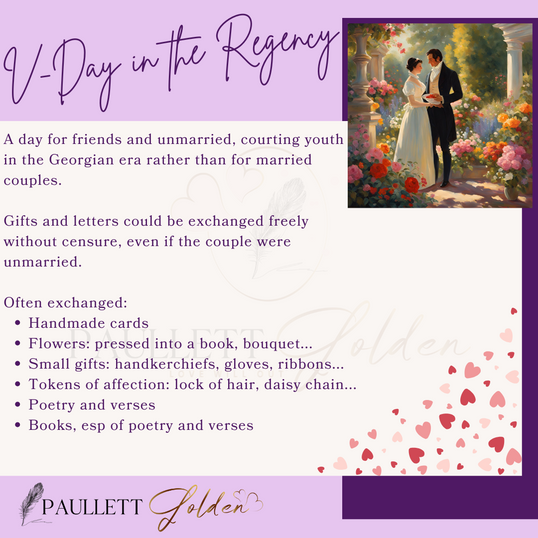Real People. Real Conflict. Real Romance.
Historical Romance
in the style of Jane Austen

Saint Valentine Day
Commonly exchanged gifts on Valentine's Day during the Regency
What Valentine’s Day plans do you typically make, be it an evening with the furbabies and a good book, a romantic meal with candles and roses, or perhaps a game day with your best friends over pizza?
Our Regency and Georgian era heroes and heroines would have enjoyed Saint Valentine's Day but with a little more personal flair. This was a day celebrated by all and sundry, from aristocrats to commoners—even Chaucer enjoyed V-Day! These days, V-Day is often associated with consumerism, be it mass produced Hallmark cards or heart-shaped bonbons, but V-Day card and gift exchanges have been celebrated for centuries. That said, if you're hoping for a reprieve from any V-Day marital obligations, hang in there, as there is good news on the way when it comes to who celebrated in the Regency and who didn't.
One of the most popular ways to celebrate during the Georgian era was to exchange handmade cards—think gold embossing and real lace trimming for those who could afford it or “imitation” lace by needling holes into the paper. Inside the cards would often be poems, be it one’s own or something well known. Small gifts, tokens of affection, and flowers were not uncommon. Small gifts might include handkerchiefs, brooches, gloves, ribbons, books (especially of poetry), and so forth. Tokens of affection might include locks of hair, daisy chains, miniature portrait (such as what might fit in a locket), etc. Flowers could be the quintessential bouquet from a hot house, but more likely would be in the nature of a flower pressed between the pages of a book or similar. Frank Churchill went beyond a small gift in Emma when he sent Jane Fairfax a pianoforte on Valentine’s Day—talk about setting the bar!
Something of special interest is that the no-no rule of exchanging letters and gifts between unbetrothed couples was excused on Valentine’s Day. What a perfect story plot, right? During this one day of the year, a gentleman and a young lady could exchange love poetry and tokens of affection without censure.
Curiously, this was a day for friends and the unmarried, as married couples rarely (if at all) participated in the exchange of gifts and cards (married couples are off the hook!). It was a fun and flirty day for courting individuals, secret admirers, and friends and neighbours.
If the courting gentleman lacked poetical talent, there were ample pamphlets and newspaper columns to come to the rescue, such as the 1797 The Young Man’s Valentine Writer, which is discussed in Gail Eastwood’s Risky Regencies blog post, along with some fantastic examples of handmade cards.
For the long history of the day and when it began to be celebrated, check out the article from the Jane Austen Centre as well as the article by Clare Davidson at The Conversation.
